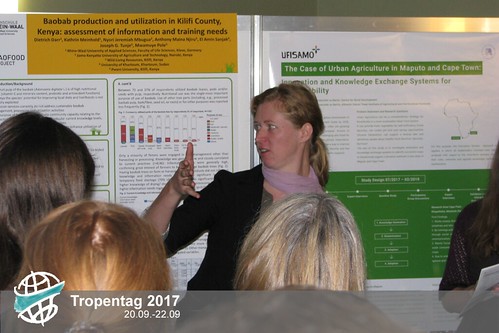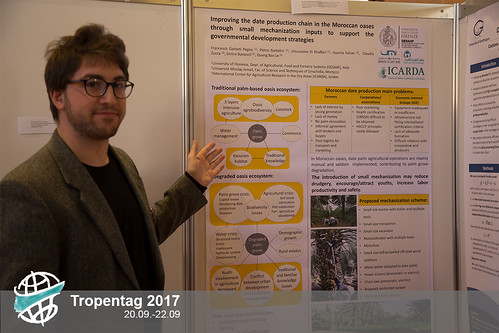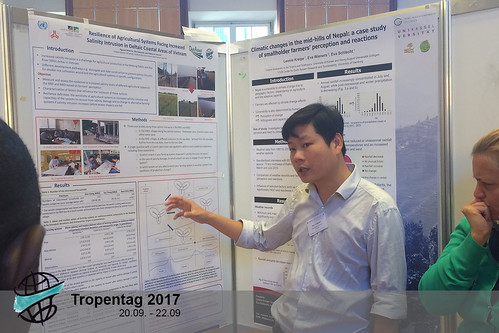Poster Sessions 2017
First Day Poster Sessions
Mon, 09/25/2017 - 17:22 — TTA guided tour through some of the poster presentations on the first day of Tropentag 2017.

Give Farmers their Agency Back!
Mon, 09/25/2017 - 00:12 — marlemkeThe answer is: centralized breeding. Unfortunately, farmers are left out of the selection, development, and maintenance of crop traits. Even if they are the producers of our local food, and should be the protagonist.
The poster session on “Knowledge Systems” focused on educational and operative strategies with the ultimate goal of bringing food sovereignty to indigenous communities. Participatory breeding is an example of one that could strengthen local communities and provide independence from big seed and fertilizer companies.
Wouldn't that be great? This would not only give small farmers more freedom, but would also banish GMOs from their plates. Two birds with one stone.


Value Chains are Valuable
Fri, 09/22/2017 - 11:38 — Hana KhanhValue chains is the hot topic currently in agricultural economics. As a result, not surprisingly, many people came to the poster session, although it was organized very late in the afternoon of the second day, just before the biggest event of the conference, the "Gala dinner’’.

This year, there were up to 15 posters registered, and they had only one hour to present their work. I felt very positive as I learned about the many attempts to find the bottlenecks in the value chains of tropical and sub-tropical products in developing countries, perhaps leading to new suggestions and solutions for farmers. While Sham UI Haq and Yee Mon Aung worked on rice and pulses in Myanmar, Hazal Akcakara from the University of Bonn, evaluated the impact of sustainability certification on palm oil.

Diverse Approaches to Understanding Farmers’ Perception
Thu, 09/21/2017 - 14:19 — Hana KhanhStarting very early in the morning of the second day of Tropentag 2017, the poster sessions on Risk and Awareness still attracted many people. It is good news that this year many presented research focused on understanding the farmers’ perception through different approaches. It also made the session more interesting with lots of discussions.
While Akary Min investigated how farmers adapt to climate change in the Central Dry Zone of Myanmar, Amie Heri-Kazi Bisimwa from Eastern of DR Congo was more inclined towards the farmers’ perceptions of land degradation in South Kivu. And Minh Tu Nguyen has been currently working on the subjective measurement of resilience of agricultural systems to increased salinity intrusion in Vietnam. More surprisingly, Emily Mutota tried to apply a new method, ‘’photovoice’’, in which she attempted to understand the perception of the local community about their own habitats by asking them to expressing it through the photos they captured. Even though, personally, I was not able to find many promising results from this research, her attempts with a new approach should be appreciated.

Tropentag Poster Session Diary
Thu, 09/21/2017 - 13:14 — marlemkeAs such, we want to know how nature behaves. We want to mimic it, and often we want to be in control of it. We sometimes fight it, and sometimes cooperate with it.
We experiment with biological agents such as fungal isolates to fight root-knot nematodes on pineapple plantations in Kenya to avoid unnecessary pesticide use. Or we compare a conventional single-culture cacao cropping system with a agroforestry system, a natural, resilient system that copes with rapid changing abiotic factors due to climate change. Of course, we don't want to deal with the origins of the problem, which are usually man-made. What about reducing waste? Rethinking nutrition? Learning to make do with less? Ultimately, we all strive for the same: living our dreams.
We Need Youth! Small mechanization to preserve Moroccan Oases
Thu, 09/21/2017 - 13:03 — giulia.rotanodariFor centuries, oases supported agriculture and sustained livelihoods in arid climates. Over the last few decades, oases in Morocco have been progressively neglected. They are fragile ecosystems and without constant care from the next generation, are facing progressive degradation. Date palms are one of the most important resources in an oasis, but as a consequence of the progressive land abandonment, the loss of knowledge and labour force are hindering its production.
The University of Florence, in collaboration with the University of Moulay Ismail and ICARDA, proposed the introduction of small machines as a possible solution to reduce the drudgery of farm work, facilitate field operations, and make agriculture more attractive for the young farmers.

However, Pietro Bartolini explained that the main limitations may be linked to access, in fact the investment cost is often not affordable for smallholders. For this reason, the proposed intervention will target local cooperatives, in order to ensure a better economic sustainability.
Terraces, Tenure and Tea
Thu, 09/21/2017 - 10:28 — schumacherlydiaAfter the interesting and inspiring first day at Tropentag 2017, people dragged themselves out of their beds to the AULA at the University of Bonn for today's morning poster session about land use and land use changes. Andreas Brueckert, head of the department of Organic Plant Production at the University of Kassel, guided us charmingly through the jungle of posters. Personal eye- and ear-catchers for me were the presentations on how the future of tea in Malawi depends on the changing climate, tenure influences land conservation, and sustainable land management works in the fragile political context of Northern Afghanistan.
As the presenter did not show up, Andreas, who was well-prepared quickly took over and concisely explained the study. He spiced it up with facts he already knew from his own research, like one major obstacle for planting trees in the socio-ecological context is the change in ownership. The one who plants the tree automatically owns it. Therefore, land tenure hinders the implementation of land conservation methods, slowing afforestation in communal land.
Christian, demonstrated another threat, not to trees but to tea. During an intensive modelling study he and his colleagues investigated the impact of climate change to tea production in Malawi. Whereas just few areas can sustain their production with incremental adaptation, large areas are at risk. As tea is an important crop for agriculture in Malawi, this outcome poses a big challenge for both farmers and researchers, as resilient varieties are needed.
Should It Be Out of Our Hands?
Thu, 09/21/2017 - 10:15 — megreslerCast under the soft morning light of an empty hall, Poster Session 2 "Markets" began in a far more intimate fashion than the session held in the space yesterday afternoon. Perhaps the combination of a smaller audience, a quieter surrounding hall (and copious coffee personally) worked together to generate conditions for a far more interactive discussion of forward-looking market-centric research.
As a self-identifying young researcher (one of the dominant themes of yesterday's Welcome Address), I am currently deeply engaged with preparations for my first poster presentation at an upcoming conference later this autumn. The opportunity to follow multiple poster sessions this week has of course reiterated the necessity of certain characteristics in delivering an effective poster presentation, but perhaps more significantly, it has unveiled a dimension of "Well, this is out of my hands..." that seems inherent to this particular form of scientific communication. I am specially referring to the presentation time and poster location. Does the random selection of your presentation hall, or whether your talk precedes or follows a coffee break, significantly impact the effectiveness of your poster presentation? With no control over these factors, I would like to ask senior researchers for advice moving forward: What strategies have you cultivated to navigate some of these challenges? How can young researchers improve for future international conference environments?





